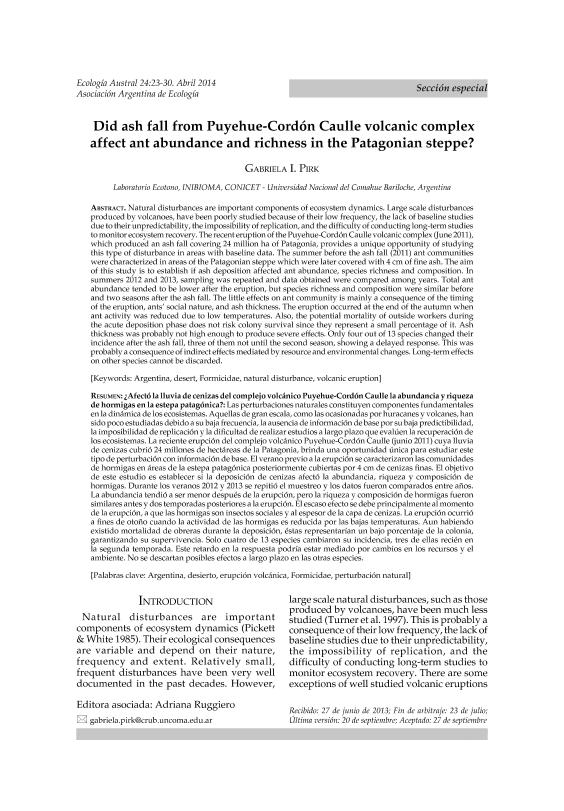Mostrar el registro sencillo del ítem
dc.contributor.author
Pirk, Gabriela Inés

dc.date.available
2017-01-25T18:18:40Z
dc.date.issued
2014-04
dc.identifier.citation
Pirk, Gabriela Inés; Did ash fall from Puyehue-Cordón Caulle volcanic complex affect ant abundance and richness in the Patagonian steppe?; Asociación Argentina de Ecología; Ecología Austral; 24; 1; 4-2014; 23-30
dc.identifier.issn
0327-5477
dc.identifier.uri
http://hdl.handle.net/11336/11901
dc.description.abstract
Las perturbaciones naturales constituyen componentes fundamentales en la dinámica de los ecosistemas. Aquellas de gran escala, como las ocasionadas por huracanes y volcanes, han sido poco estudiadas debido a su baja frecuencia, la ausencia de información de base por su baja predictibilidad, la imposibilidad de replicación y la dificultad de realizar estudios a largo plazo que evalúen la recuperación de los ecosistemas. La reciente erupción del complejo volcánico Puyehue-Cordón Caulle (junio 2011) cuya lluvia de cenizas cubrió 24 millones de hectáreas de la Patagonia, brinda una oportunidad única para estudiar este tipo de perturbación con información de base. El verano previo a la erupción se caracterizaron las comunidades de hormigas en áreas de la estepa patagónica posteriormente cubiertas por 4 cm de cenizas finas. El objetivo de este estudio es establecer si la deposición de cenizas afectó la abundancia, riqueza y composición de hormigas. Durante los veranos 2012 y 2013 se repitió el muestreo y los datos fueron comparados entre años. La abundancia tendió a ser menor después de la erupción, pero la riqueza y composición de hormigas fueron similares antes y dos temporadas posteriores a la erupción. El escaso efecto se debe principalmente al momento de la erupción, a que las hormigas son insectos sociales y al espesor de la capa de cenizas. La erupción ocurrió a fines de otoño cuando la actividad de las hormigas es reducida por las bajas temperaturas. Aun habiendo existido mortalidad de obreras durante la deposición, éstas representarían un bajo porcentaje de la colonia, garantizando su supervivencia. Solo cuatro de 13 especies cambiaron su incidencia, tres de ellas recién en la segunda temporada. Este retardo en la respuesta podría estar mediado por cambios en los recursos y el ambiente. No se descartan posibles efectos a largo plazo en las otras especies.
dc.description.abstract
Natural disturbances are important components of ecosystem dynamics. Large scale disturbances produced by volcanoes, have been poorly studied because of their low frequency, the lack of baseline studies due to their unpredictability, the impossibility of replication, and the difficulty of conducting long-term studies to monitor ecosystem recovery. The recent eruption of the Puyehue-Cordón Caulle volcanic complex (June 2011), which produced an ash fall covering 24 million ha of Patagonia, provides a unique opportunity of studying this type of disturbance in areas with baseline data. The summer before the ash fall (2011) ant communities were characterized in areas of the Patagonian steppe which were later covered with 4 cm of fine ash. The aim of this study is to establish if ash deposition affected ant abundance, species richness and composition. In summers 2012 and 2013, sampling was repeated and data obtained were compared among years. Total ant abundance tended to be lower after the eruption, but species richness and composition were similar before and two seasons after the ash fall. The little effects on ant community is mainly a consequence of the timing of the eruption, ants' social nature, and ash thickness. The eruption occurred at the end of the autumn when ant activity was reduced due to low temperatures. Also, the potential mortality of outside workers during the acute deposition phase does not risk colony survival since they represent a small percentage of it. Ash thickness was probably not high enough to produce severe effects. Only four out of 13 species changed their incidence after the ash fall, three of them not until the second season, showing a delayed response. This was probably a consequence of indirect effects mediated by resource and environmental changes. Long-term effects on other species cannot be discarded.
dc.format
application/pdf
dc.language.iso
eng
dc.publisher
Asociación Argentina de Ecología

dc.rights
info:eu-repo/semantics/openAccess
dc.rights.uri
https://creativecommons.org/licenses/by-nc-sa/2.5/ar/
dc.subject
Argentina
dc.subject
Desert
dc.subject
Formicidae
dc.subject
Volcanic Eruption
dc.subject.classification
Ecología

dc.subject.classification
Ciencias Biológicas

dc.subject.classification
CIENCIAS NATURALES Y EXACTAS

dc.title
Did ash fall from Puyehue-Cordón Caulle volcanic complex affect ant abundance and richness in the Patagonian steppe?
dc.title
¿Afectó la lluvia de cenizas del complejo volcánico Puyehue-Cordón Caulle la abundancia y riqueza de hormigas en la estepa patagónica?
dc.type
info:eu-repo/semantics/article
dc.type
info:ar-repo/semantics/artículo
dc.type
info:eu-repo/semantics/publishedVersion
dc.date.updated
2016-12-12T14:21:37Z
dc.journal.volume
24
dc.journal.number
1
dc.journal.pagination
23-30
dc.journal.pais
Argentina

dc.journal.ciudad
Buenos Aires
dc.description.fil
Fil: Pirk, Gabriela Inés. Consejo Nacional de Investigaciones Científicas y Técnicas. Centro Científico Tecnológico Patagonia Norte. Instituto de Investigación en Biodiversidad y Medioambiente; Argentina. Universidad Nacional del Comahue. Centro Regional Universitario Bariloche. Laboratorio de Ecotono; Argentina
dc.journal.title
Ecología Austral

dc.relation.alternativeid
info:eu-repo/semantics/altIdentifier/url/http://ojs.ecologiaaustral.com.ar/index.php/Ecologia_Austral/article/view/34
dc.relation.alternativeid
info:eu-repo/semantics/altIdentifier/url/http://ref.scielo.org/m35gvb
Archivos asociados
